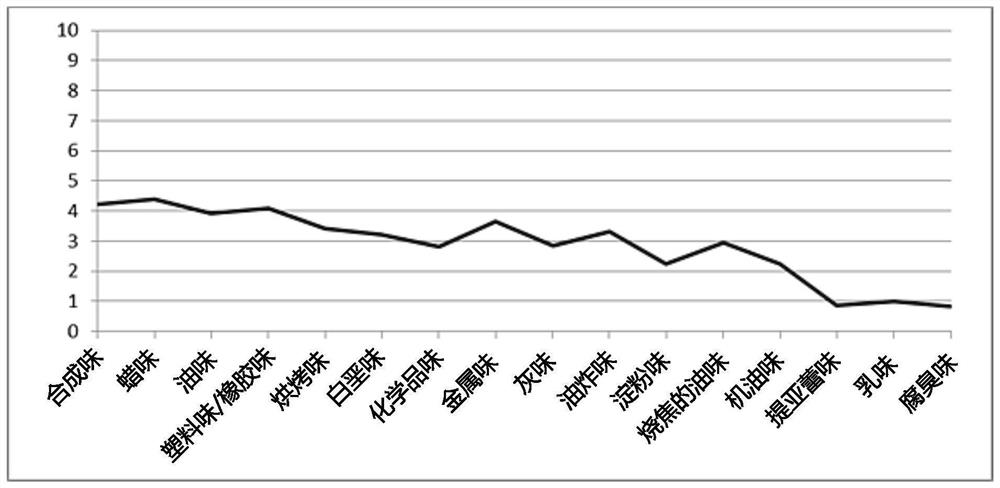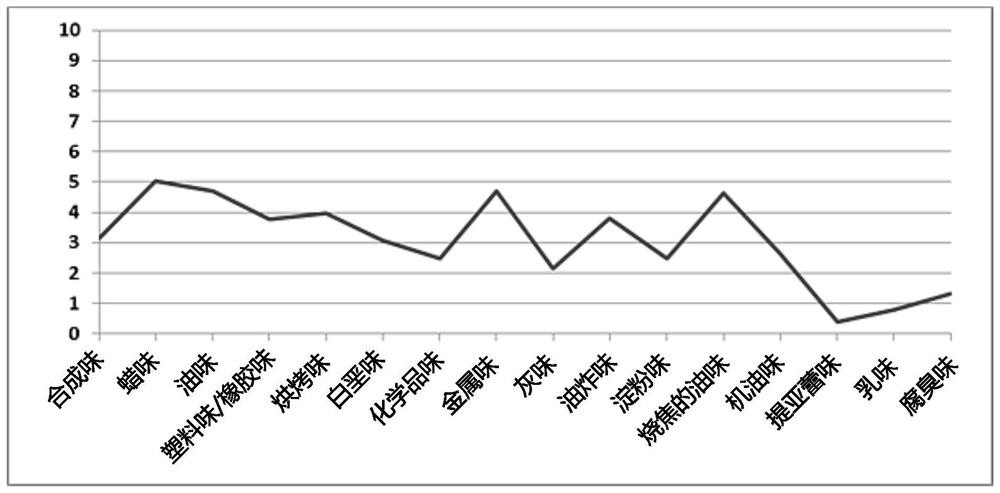Composition for limiting or eliminating peculiar smell perception of raw materials in soap base
A composition and odor technology, applied in soap detergent composition, fragrance-containing detergent composition, detergent composition, etc., can solve the problems of low detection threshold and difficulty
- Summary
- Abstract
- Description
- Claims
- Application Information
AI Technical Summary
Problems solved by technology
Method used
Image
Examples
Embodiment 1
[0133] Example 1: Characterization of Raw Odor in a Representative Laundry Soap Base
[0134] A behavioral sensory evaluation method called Quantitative Descriptive Analysis (QDA) developed by Tragon Corporation in 1974 was used to identify and characterize raw odor present in seven representative laundry soap bases. QDA uses descriptive panels to measure sensory characteristics of products. Panelists use their senses to identify perceived similarities and differences in products and express those perceptions in their own words.
[0135] During language development, group members receive products to describe them. All generated terms were then evaluated on a 6-point non-linear scale from 0 (no odor perceived) to 5 (strong odor). To reduce the list of attributes, Dravniek means were calculated and multidimensional and ANOVA were run. Sixteen sensory terms were identified to describe the raw off-flavors present in seven representative laundry soap bases (assessed neat): tiare...
Embodiment 2
[0143] Example 2: Characterization of off-flavor antagonist systems according to the morphologies presented herein
[0144] The sensory terms attributed to the representative laundry soap bases identified and described in Example 1 above are the result of the presence of certain off-flavor molecules in the headspace surrounding the laundry soap base. Figure 8 The ability of the following odor counteracting compositions to reduce the headspace concentration of ethylhexyl acetate (earth, dirty odor profiles) and 2-undecanone (oily, waxy odor profiles) is reported.
[0145] IUPAC name Amount (wt%) common name Propane-2-yl myristate 22% 1-(2,6,6-Trimethyl-1-cyclohex-2-enyl)pent-1-en-3-one N- 15% 3a,4,5,6,7,7a-hexahydro-4,7-methinden-6-yl acetate 10% (±)-3,7-Dimethyl-1,6-octadien-3-ol 6% 2,6-Dimethyloct-7-en-2-ol 4% other 43%
Embodiment 3
[0146] Example 3: User testing of laundry soaps treated according to the methods disclosed herein
[0147] The odor counteracting compositions described herein were tested for their ability to limit, reduce or eliminate raw odor perception to commercial laundry soap bases by users in Nigeria (skin cleansing base) and Côte d'Ivoire (laundry base). The ability of the odor counteracting composition to limit, reduce or eliminate the perception of raw odor was evaluated in dry soap powder in the box (pure state) and using wet towels soaked in laundry detergent solution for 10 minutes prior to evaluation ( wet to simulate the product in use).
[0148] In the first study conducted in Côte d'Ivoire, users were asked to evaluate a benchmark base without any perfuming composition (CDI base), a benchmark base containing 0.35 wt% aloe chamomile fragrance (CDI base aloe chamomile 0.35 %) and a benchmark base containing 0.31 wt% Optima fragrance (CDI base Optima 0.31%), and they were asked...
PUM
 Login to View More
Login to View More Abstract
Description
Claims
Application Information
 Login to View More
Login to View More - R&D
- Intellectual Property
- Life Sciences
- Materials
- Tech Scout
- Unparalleled Data Quality
- Higher Quality Content
- 60% Fewer Hallucinations
Browse by: Latest US Patents, China's latest patents, Technical Efficacy Thesaurus, Application Domain, Technology Topic, Popular Technical Reports.
© 2025 PatSnap. All rights reserved.Legal|Privacy policy|Modern Slavery Act Transparency Statement|Sitemap|About US| Contact US: help@patsnap.com



